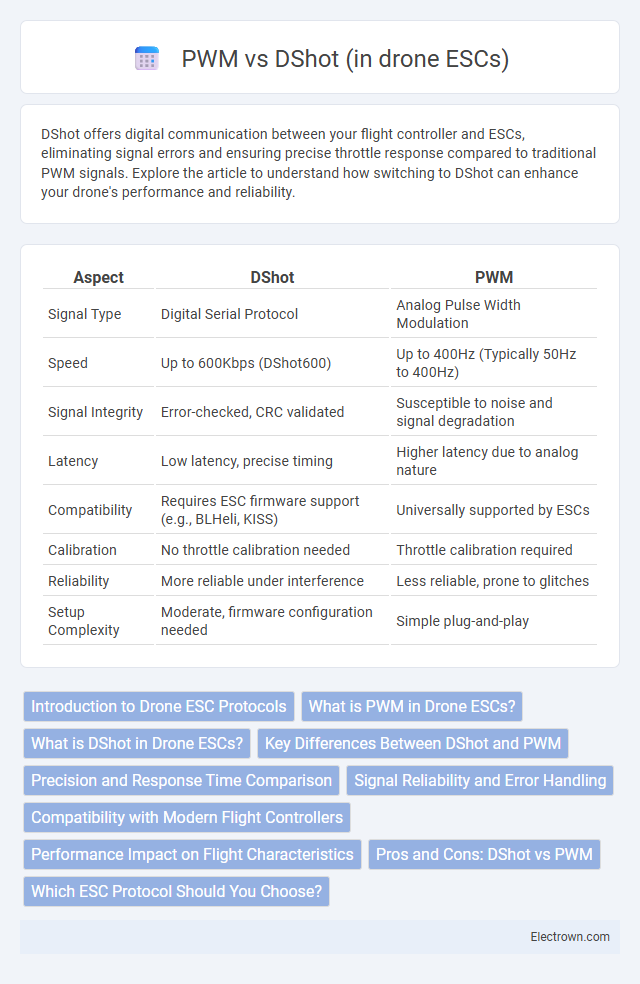DShot offers digital communication between your flight controller and ESCs, eliminating signal errors and ensuring precise throttle response compared to traditional PWM signals. Explore the article to understand how switching to DShot can enhance your drone's performance and reliability.
Table of Comparison
| Aspect | DShot | PWM |
|---|---|---|
| Signal Type | Digital Serial Protocol | Analog Pulse Width Modulation |
| Speed | Up to 600Kbps (DShot600) | Up to 400Hz (Typically 50Hz to 400Hz) |
| Signal Integrity | Error-checked, CRC validated | Susceptible to noise and signal degradation |
| Latency | Low latency, precise timing | Higher latency due to analog nature |
| Compatibility | Requires ESC firmware support (e.g., BLHeli, KISS) | Universally supported by ESCs |
| Calibration | No throttle calibration needed | Throttle calibration required |
| Reliability | More reliable under interference | Less reliable, prone to glitches |
| Setup Complexity | Moderate, firmware configuration needed | Simple plug-and-play |
Introduction to Drone ESC Protocols
Drone ESC protocols like DShot and PWM define communication between the flight controller and electronic speed controllers, crucial for motor performance and responsiveness. DShot offers digital signals with error-checking and precise throttle control, while PWM uses analog pulses with less accuracy and potential signal noise. Choosing DShot enhances your drone's reliability and flight precision compared to traditional PWM signaling.
What is PWM in Drone ESCs?
PWM (Pulse Width Modulation) in drone ESCs is a signal modulation technique that controls motor speed by varying the width of voltage pulses sent from the flight controller to the ESC. The ESC interprets these pulses into specific throttle commands, adjusting the motor's rotational speed accordingly. This method, while widely used, has limitations in signal resolution and latency compared to digital protocols like DShot.
What is DShot in Drone ESCs?
DShot is a digital communication protocol used in drone ESCs (Electronic Speed Controllers) to precisely control motor speed by sending encoded digital signals instead of traditional analog PWM signals. Unlike PWM, which relies on varying pulse widths to convey throttle commands, DShot transmits discrete packetized data with built-in error checking for improved reliability and faster response times. This results in more accurate motor control, reduced latency, and enhanced ESC synchronization, crucial for high-performance drone flight.
Key Differences Between DShot and PWM
DShot delivers digital signaling with precise, error-checked commands, whereas PWM relies on analog pulses subject to timing inaccuracies and signal noise. DShot supports higher update frequencies up to 48 kHz, improving ESC response and motor control compared to PWM's typical 50 Hz to 500 Hz range. Integration of telemetry data with DShot enhances flight performance diagnostics, a feature absent in traditional PWM ESC communication.
Precision and Response Time Comparison
DShot offers superior precision over PWM by utilizing digital signals that eliminate signal noise and timing variations inherent in PWM's analog pulses. The response time in DShot is significantly faster due to its direct digital communication, enabling quicker throttle updates and enhanced ESC responsiveness. This precision and reduced latency make DShot ideal for high-performance drones requiring rapid and accurate motor control.
Signal Reliability and Error Handling
DShot offers superior signal reliability compared to PWM due to its digital communication protocol, which reduces noise susceptibility and ensures precise throttle commands for your drone's ESC. Unlike PWM's analog pulses, DShot includes built-in error detection and correction mechanisms, enabling immediate identification and correction of transmission errors to prevent misfires or throttle jitter. This robust error handling enhances flight stability and responsiveness, making DShot the preferred choice for high-performance drone applications.
Compatibility with Modern Flight Controllers
DShot offers superior compatibility with modern flight controllers by providing a digital signal that reduces noise and improves throttle precision compared to PWM's analog signal. Many contemporary ESCs and flight controllers are designed to natively support DShot protocols such as DShot600 and DShot1200, enhancing responsiveness and reducing signal errors. This digital communication standard also enables advanced features like telemetry feedback, which PWM lacks, making DShot the preferred choice for high-performance drone setups.
Performance Impact on Flight Characteristics
DShot ESC protocol offers precise digital communication that significantly reduces latency and signal jitter compared to traditional PWM signals, enhancing your drone's responsiveness and flight stability. With improved timing accuracy, DShot enables smoother throttle control and faster motor response, which directly translates into better maneuverability and tighter handling during complex flight patterns. Performance gains from DShot contribute to lower risk of motor desynchronization and more consistent ESC behavior under high-demand flight conditions.
Pros and Cons: DShot vs PWM
DShot offers advantages like digital signal accuracy, reduced latency, and built-in error checking, enhancing your drone's ESC responsiveness compared to traditional PWM signals. PWM provides simplicity and broad compatibility with existing ESCs but suffers from analog signal noise and calibration requirements that can affect performance. Choosing between DShot and PWM depends on your need for precision and reliability versus ease of setup and hardware compatibility.
Which ESC Protocol Should You Choose?
DShot offers superior signal accuracy and reduced latency compared to PWM, providing precise throttle control essential for advanced drone performance. Unlike PWM, DShot includes error-checking, enhancing flight reliability and minimizing ESC communication issues. Your choice should favor DShot if you require flawless ESC response and smooth motor operation in high-performance or racing drones.
DShot vs PWM (in drone ESCs) Infographic

 electrown.com
electrown.com